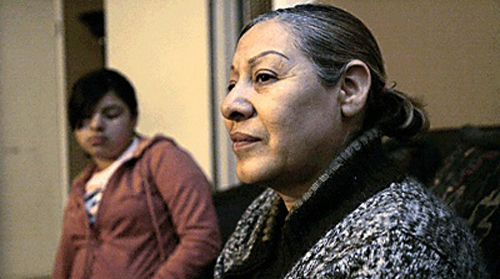
Maria Olvera with Valory, one of the two grandchildren she is raising in Altadena, Calif.
Where do children live?
Some children live at home. Sometimes, the families are their own extended families. Often they are their grandparents’ homes. Sometimes the parents have been taken by illness. Other times, the market has insisted that mothers and fathers travel extraordinary distances and stay away for long periods of time. And sometimes the parents have been deported.
Other children live in family homes that are worksites and worse. These children might be domestic workers, and they live as strangers in their own domiciles.
In Burkina Faso, for example, children, especially girls, work as street vendors, or hawkers, and as domestic workers. Legally, domestic work is considered “light work”, and so children officially can begin working in households at the age of 15. In fact, children, mostly girls, begin as young as 7. Almost half of all children in Burkina Faso work, and proportionately the girls outnumber the boys.
The local Red Cross has a child labor project that is trying to help child domestic workers. Other local NGOs also are trying to help child domestic workers. How? The NGOs are offering girls training in cleaning and housekeeping, and, occasionally, reading, writing, and sewing. The Red Cross is sending stern, `blunt’ text messages to government officials, employers, traditional leaders, teachers, business owners and housewives. Here’s one example: ““Employers: domestics have the same rights as your children. Stop under-paying them; stop subjecting them to mistreatment, sexual violence, and long hours”.
Who are the children? They are typically described as children “from rural areas where there are few work opportunities”, and so they are sent, or some would say trafficked, to the cities, in this case Ouagadougou or Bobo-Dioulosso. They have the same rights as your children? Hardly. `Your children’ go to school. `Your children’ inhabit days and lives that aren’t measured by wage scales and work opportunities. `Your children’ are … your children, and their opportunities are the opportunities of childhood. These children are not `your children’. If they were, their situation would not be described in terms of lack of work but rather lack of school.
But tell me, where do the children live?
In the United States, one of every ten children lives with their grandparents. Close to three million children live with a grandparent or grandparents. Close to three million grandparents are the primary caregivers to the children living with them. Of the three million grandparents, 62%, or a little less then two million, are women. While the primary caregiver grandparents are disproportionately African American and Latina, the numbers are increasing, rapidly, among White grandparents as well. Of the primary caregiver grandparents, 65% are either poor or near-poor.
This development is considered a social trend. For Latina grandmothers, it is often complicated by another `social trend’: deportation. For example, Maria Olvera takes care of two of her grandchildren. Their mother, Maria Reyes, was deported, returned to Mexico, where she now lives, on the border in Tijuana. Their father died in 2008. Maria Reyes has four children. The other two stay with an aunt nearby. The four siblings come together daily, to encourage a sense of family. Meanwhile, Maria Olvera is herself undocumented. A survivor of domestic abuse, she helped authorities locate and prosecute her abuser. Now she waits to see if she can obtain a U visa. Meanwhile, she has little or no formal rights or claims to the children.
And if Maria Olvera looks around, she will already know another `social trend’ that legal scholars are just beginning to discover and document: the deportation of grandparent caregivers, and in particular of grandmothers. Parents gone, grandparents under threat, where do you think the children live? Limbo.
The illegal but common child domestic workers of Burkina Faso, the grandchildren of undocumented grandparent primary caregivers in the United States, live formally, officially … nowhere. They are shadows. As nations design and implement so-called austerity programs, the world of shadow children expands as it grows more thickly populated. In the United Kingdom, for example, it is anticipated that, as a result of so-called austerity budget cuts, 300,000 children will be shoved into poverty. Like a bird, child poverty is set to soar.
But tell me, where will the children live?
(Photo Credit: Sarah Reingewirtz / San Gabriel Valley News Group / El Nuevo Sol)